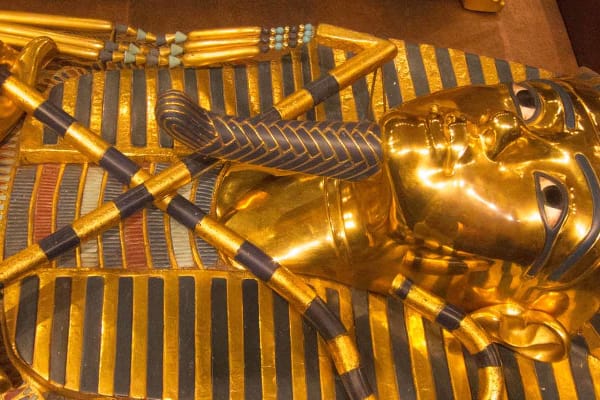
Is Gold Magnetic?
The simple answer is 'no', gold is not magnetic. However, without further explanation, items of gold jewellery will likely get incorrectly rejected, so let's delve a little deeper!

Gold has been found in various locations worldwide, with significant historical discoveries occurring in regions such as California (during the Gold Rush), South Africa, Australia, and Nevada. Currently, leading countries for gold production include China, Australia, and South Africa, reflecting the ongoing global significance of gold mining.
Ancient civilisations were remarkable in their pursuit of gold, showcasing their resourcefulness and understanding of the land. The Egyptians, for example, were heavily engaged in gold mining from approximately 2450 to 2600 BCE. They primarily extracted gold from the Nubian Desert, a place rich in untapped potential. Just imagine the scene: vast sands stretching under the blazing sun, with labourers tirelessly working to uncover this precious metal that would eventually adorn the pharaohs' tombs, symbolising power and eternal life. It's estimated that thousands of kilograms were mined yearly, cementing gold's role as a vital resource in ancient Egyptian society.
As we shift our focus toward Europe, we find that the quest for gold also coursed through Roman history.
The Roman Empire was infamous for its extensive mining operations, with one of the most notable sites being Las Médulas in Spain. This region tells a compelling story of innovation; Romans ingeniously constructed a complex system of aqueducts and sluices designed to wash away dirt while leaving gold behind. They wielded engineering skills that were ahead of their time, demonstrating their ability to harness nature to extract unimaginable wealth. Estimates suggest that around 165,000 kilograms of gold poured out from Las Médulas alone across several centuries of mining. The sheer scale astounds, revealing the desire for riches and an intricate connection between engineering and mining practices that laid the groundwork for future industries.
But it wasn't just these two great civilisations; countless others ventured into their own quests for golden treasures.
Over in Anatolia, known today as Turkey, early civilisations thrived on gold deposits found particularly in the river sands of the Pactolus River. Here, legends tell tales of miners washing grains of gold straight from the riverbed—a practice dating back to around 700 BCE that would spark humanity's fascination with gold's allure. Meanwhile, across the Atlantic in South America, the Incas skillfully extracted over 1,000 tons of gold from their mountainous terrain long before European conquerors set foot on their lands. Their ability to locate and utilise resources within challenging environments speaks volumes about their cultural significance tied to gold.
Each site carries a narrative; however, they share one undeniable truth.
These ancient sources remind us how creatively humankind has approached the extraction of natural resources throughout history. Gold has served multifaceted purposes—from currency and jewelry to religious artifacts—indicating its deep cultural significance across civilisations. Exploring these historical foundations leads us naturally to more contemporary reflections on mining practices and their lasting impact on local communities and economies.
The legacy of gold mining is woven into the very fabric of numerous regions, each with its own fascinating narrative. California's Gold Rush, which kicked off in 1848, is a prime example. Over 300,000 hopefuls flooded into the state, driven by dreams of striking it rich. This significant migration didn't just alter California's demographics; it laid the groundwork for the state's economic future and cultural identity. In towns like Sacramento and San Francisco, entire communities sprang up almost overnight, bustling with activity, opportunity, and often, desperation.
It's astonishing to consider that during this rapid expansion, over 750,000 pounds of gold were extracted from the Sierra Nevada region alone. This monumental figure underscores the sheer volume of wealth that was both discovered and disseminated throughout the country. Yet the ripple effects went deeper than just gold; communities developed new infrastructures encompassing banks, shops, and homes to support the influx of newcomers.
Some argue that the Klondike Gold Rush in Canada (1896-1899) was even more culturally impactful. Although it attracted fewer miners—about 100,000 prospectors migrated north—only around 30,000 to 40,000 successfully reached the goldfields. Yet those who did faced grueling conditions in search of approximately 1.5 million ounces of gold found in places like Bonanza Creek.
These statistics illustrate the allure of gold and the relentless spirit of human endeavour against overwhelming odds. The Klondike experience shifted public attention towards a different type of wilderness—a rugged frontier that challenged and ultimately shaped its visitors. Miners braved extreme weather conditions and treacherous terrains in their quest for riches, leading to tales of both triumph and tragedy.
Similar themes resonate throughout other historical mining regions around the globe, revealing an intricate tapestry of ambition fueled by the magic of gold discovery.
Emerging in 1886 and known as home to over 40% of the world's gold reserves, Witwatersrand has seen more than 1.5 billion ounces mined since its discovery. This region garnered international attention as it became crucial for global gold production—its industrial potential reshaping economies far beyond South Africa itself. It played an instrumental role in the political landscape while drawing waves of immigrants seeking a better life amidst fresh opportunities.
The stories told through these iconic gold mining sites exemplify how resource discoveries can dramatically alter local demographic trends and economic trajectories.
Additionally, modern times have not diminished gold's value or allure; consider the Carlin Trend in Nevada, which has been producing gold since 1961 and yielding over 87 million ounces thus far. Recognized as one of the largest gold-producing areas globally, its advanced mining techniques showcase how technology has evolved alongside our understanding of mineral extraction.
While historic mining sites capture our imagination with their thrilling narratives of hardship and success, they illuminate a fundamental truth about natural resources—a truth that continues to influence how we engage with such treasures today. Each golden nugget harvested has not only changed individual lives but sent ripples across economies and societies for generations.
As we reflect on these storied lands where fortunes were made—and sometimes lost—we will explore further how contemporary practices continue to shape our relationship with this precious metal, which remains an economic powerhouse.
The quest for gold continues across the globe, driven not just by demand, but also by advances in mining technology that make extraction safer and more efficient. Among these major modern mining sites is the Grasberg Mine in Indonesia, recognized as the largest gold mine in the world. Producing a staggering 2.7 million ounces annually, its remarkable output showcases both the scale and depth of modern mining operations.
This mine reflects not only technological advancements but also highlights the geographical diversity of gold mining today.
Right next in line is Uzbekistan's Muruntau Mine, which yields around 2 million ounces yearly. This site has been a prominent player in the gold market thanks to its extensive reserves and large-scale operations. The vast open-pit mine was not initially developed for gold alone but has since become one of the world's largest producers.
Moving on to Nevada, USA, we find the Carlin Trend Gold Mine, producing approximately 1.7 million ounces annually. What makes Carlin particularly interesting is its superior logistics and infrastructure, making it an efficient workhorse in gold production. Here's a fun fact: most of its gold deposits are relatively easy to process—this efficiency reduces costs. It speeds up recovery rates, reinforcing its place as a powerhouse in modern mining.
The Olimpiada Gold Mine situated in Russia follows closely with a yearly output of about 1.4 million ounces. It stands out due to its harsh environment and challenging weather conditions, pushing technology to adapt accordingly. Innovations here involve using specialised equipment designed to withstand extreme cold while maintaining operational efficiency.
| Mining Site | Location | Annual Production |
|---|---|---|
| Grasberg Mine | Indonesia | 2.7 million oz |
| Muruntau Mine | Uzbekistan | 2.0 million oz |
| Carlin Trend Gold Mine | USA (Nevada) | 1.7 million oz |
| Olimpiada Gold Mine | Russia | 1.4 million oz |
| Pueblo Viejo Gold Mine | Dominican Republic | 1.3 million oz |
Lastly, we can't overlook the Pueblo Viejo Gold Mine in the Dominican Republic, producing around 1.3 million ounces annually. This site exemplifies how partnerships between governments and private enterprises can harness natural resources responsibly while driving economic growth.
Exploring these highlights of contemporary gold mining also forces us to consider the geological factors that influence where these precious metals are found and extracted most effectively.
Gold doesn't just pop up randomly; its presence is intricately linked to various geological phenomena. Geologists play a crucial role in deciphering where you might find gold by classifying deposits into two main categories: primary, also known as lode gold, and secondary, referred to as placer gold. This classification helps pinpoint where the chances of striking it rich may be highest.
Lode gold is typically found encapsulated within quartz veins or other host rocks. These formations are created through intense geological pressures and heat over millions of years that cause minerals to crystallize. A classic example would be the Mother Lode in California, where some of the richest discoveries were documented during the Gold Rush era.
The Witwatersrand Basin in South Africa is another prime example. It is a powerhouse site where over 40% of the world's historically mined gold originated. Such regions are often explored thoroughly before deeper mining is attempted because they have been proven to yield immense quantities of precious metals.
Understanding these geological formations assists seasoned prospectors and provides important predictive insights regarding potential new mining sites. Knowing that lode gold deposits can often be accompanied by specific rock types or geological structures offers advantages when exploring untested areas.
On the other hand, we have placer gold, which typically rests on top or close to the surface in sedimentary deposits. This type often forms through erosion that has carried gold away from its primary source and deposited it in riverbeds or around stream beds.
Rivers like California's American River saw countless prospectors panning for placer gold during historic rushes. Here, a good swirling motion with a pan could reveal glimmers of gold at virtually anyone's fingertips, showcasing how accessible this resource can become through natural processes.
Moreover, understanding the differences between lode and placer types impacts today's mining strategies and technologies. Following that line of thought, we'll examine how surface finds like nuggets and placers have shaped the events and narratives surrounding gold discovery.
Unlike deep mining, surface finds—especially those precious nuggets and placer deposits—have captured the imagination of many over the years. Placer deposits are created when gold particles are weathered from rock veins, making their way into riverbeds, streams, and often beaches. This process has allowed countless prospectors to scoop up gold with relative ease compared to the intense labour and uncertainty of deep mining operations. One notable triumph in this arena was the discovery of the Welcome Stranger nugget in 1869.
This astonishing find weighed an incredible 72 kilograms (157.7 pounds) and became a legendary symbol of fortune and luck. Discovered by John Deason and Richard Oates near Moliagul, Victoria, Australia, it exemplified how a moment's chance could lead to life-altering wealth. The sheer dimensions of this nugget allow us to grasp how even a singular find can reshape one's destiny.
Gold was not just a metal; it represented hope and opportunity for many early miners who risked everything for a glimpse of glory.
Surprisingly small quantities of gold can be found in placer deposits today, yet their historical significance remains monumental. Contemporary mining techniques still use dredging, as seen in locations like Nome, Alaska. However, due to growing environmental concerns, there is an increasing awareness about sustainability in mining practices. Restricting the impact on local ecosystems while still reaping the benefits of placer mining represents a critical balance that miners must strive to achieve.
Today's prospectors have evolved their methods to harness more effective strategies when searching for surface gold. Dredging continues to be an active practice, but equipment has become more advanced, allowing miners to sift through river sediment efficiently and recover gold without excessive environmental harm.
Consider using tools like metal detectors or gold pans; they can be remarkably useful for identifying potential sites where nuggets may lie beneath the surface. The thrill lies in what can be discovered and in mastering these techniques through practice and patience.
Each discovery of gold contributes to our understanding of geology and mineralization processes, further enriching our knowledge about the world while fostering respect for our natural environment. As we continue this journey, we will focus on the various methods used to uncover these hidden treasures below the earth's surface.
Gold discovery has come a long way from the early days of panning in riverbeds to today's use of cutting-edge technology. Traditional techniques like panning and sluicing are still revered for their effectiveness on a small scale, but they require considerable labour and time. While these methods allow for a direct connection with Mother Nature, they often yield limited results compared to modern advancements.
As our understanding of geology has progressed, so too have the techniques miners employ in their quest for gold.
One prominent modern technique involves the use of geophysical methods such as ground-penetrating radar (GPR) and seismic surveys. These technologies allow miners to detect gold deposits deep beneath the earth without visible signs at the surface. Ground-penetrating radar works like a sophisticated sonar system, sending waves into the ground and analyzing the reflected signals. This method is invaluable in remote regions where traditional prospecting would be impractical, such as some areas in northern Canada. Therefore, GPR provides an efficient means to map subterranean structures that could lead to significant gold finds.
Moving beyond detection methods, there's also a notable intersection between chemistry and mining strategies.
Geochemical analysis is crucial in pinpointing gold-rich sites by examining soil and rock samples. Geochemists can effectively identify regions that might harbour valuable deposits by testing for trace elements—such as gold, silver, and various minerals. For instance, geochemical sampling has guided explorations toward promising targets in places like West Africa, where natural resources abound, by mapping out elemental compositions indicative of gold presence. This scientific approach enhances accuracy in locating deposits and reduces costs associated with exploratory drilling.
With advancements in data collection, another breakthrough has emerged in exploring large mineralized zones.
Utilizing satellite imaging is one of the most revolutionary advances in gold exploration, allowing geologists to view extensive areas from above and identify large mineralised zones efficiently. By analysing satellite data, researchers have discovered new gold-rich regions, such as the high-elevation Andes in South America. Remote sensing technology provides detailed images that help delineate geological features and changes across vast terrains, which may indicate potential gold-bearing formations. This technique complements traditional groundwork and demonstrates that sometimes the best discoveries come from a different perspective—literally!
Consequently, both professional miners and hobbyists can benefit from adopting these innovative methods, which can significantly boost their odds of uncovering hidden treasures buried beneath the earth's surface.
In summary, the evolution of gold discovery techniques showcases a blend of traditional methods with groundbreaking technology, shaping how we uncover valuable resources today. The story of gold mining continues as advancements drive exploration into new frontiers.

The simple answer is 'no', gold is not magnetic. However, without further explanation, items of gold jewellery will likely get incorrectly rejected, so let's delve a little deeper!

Information about the California gold rush, when it started and who was president.

Ancient Egypt can be categorised into different periods depending on the dynasty which was ruling the country.